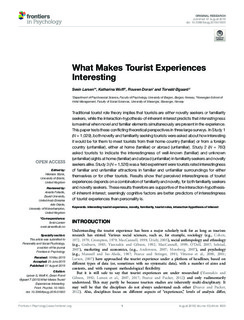| dc.contributor.author | Larsen, Svein | |
| dc.contributor.author | Wolff, Katharina | |
| dc.contributor.author | Doran, Rouven | |
| dc.contributor.author | Øgaard, Torvald | |
| dc.date.accessioned | 2020-02-21T08:54:14Z | |
| dc.date.available | 2020-02-21T08:54:14Z | |
| dc.date.created | 2019-08-07T17:15:13Z | |
| dc.date.issued | 2019-08 | |
| dc.identifier.citation | Larsen, S., Wolff, K., Douran, R. et al. (2019) What makes tourist experiences interesting. Frontiers in Psychology, 10:1603 1-12. | nb_NO |
| dc.identifier.issn | 1664-1078 | |
| dc.identifier.uri | http://hdl.handle.net/11250/2643149 | |
| dc.description.abstract | Traditional tourist role theory implies that tourists are either novelty seekers or familiarity seekers, while the interaction-hypothesis-of-inherent-interest predicts that interestingness is maximal when novel and familiar elements simultaneously are present in the experience. This paper tests these conflicting theoretical perspectives in three large surveys. In Study 1 (N = 1,029), both novelty and familiarity seeking tourists were asked about how interesting it would be for them to meet tourists from their home country (familiar) or from a foreign country (unfamiliar), either at home (familiar) or abroad (unfamiliar). Study 2 (N = 760) asked tourists to indicate the interestingness of well-known (familiar) and unknown (unfamiliar) sights at home (familiar) and abroad (unfamiliar) in familiarity seekers and novelty seekers alike. Study 3 (N = 1,526) was a field experiment were tourists rated interestingness of familiar and unfamiliar attractions in familiar and unfamiliar surroundings for either themselves or for other tourists. Results show that perceived interestingness of tourist experiences depends on a combination of familiarity and novelty, for both familiarity seekers and novelty seekers. These results therefore are supportive of the interaction-hypothesis-of-inherent-interest; seemingly cognitive factors are better predictors of interestingness of tourist experiences than personality is. | nb_NO |
| dc.language.iso | eng | nb_NO |
| dc.publisher | Frontiers Media S.A. | nb_NO |
| dc.rights | Navngivelse 4.0 Internasjonal | * |
| dc.rights.uri | http://creativecommons.org/licenses/by/4.0/deed.no | * |
| dc.subject | turisme | nb_NO |
| dc.subject | reiseliv | nb_NO |
| dc.subject | reiselivsnæringen | nb_NO |
| dc.title | What makes tourist experiences interesting | nb_NO |
| dc.type | Journal article | nb_NO |
| dc.type | Peer reviewed | nb_NO |
| dc.description.version | publishedVersion | nb_NO |
| dc.rights.holder | Copyright © 2019 Larsen, Wolff, Doran and Øgaard. | nb_NO |
| dc.subject.nsi | VDP::Social science: 200 | nb_NO |
| dc.source.pagenumber | 1-12 | nb_NO |
| dc.source.volume | 10:1603 | nb_NO |
| dc.source.journal | Frontiers in Psychology | nb_NO |
| dc.identifier.doi | 10.3389/fpsyg.2019.01603 | |
| dc.identifier.cristin | 1714716 | |
| cristin.unitcode | 217,7,6,0 | |
| cristin.unitname | Norsk hotellhøgskole | |
| cristin.ispublished | true | |
| cristin.fulltext | original | |
| cristin.qualitycode | 2 | |

